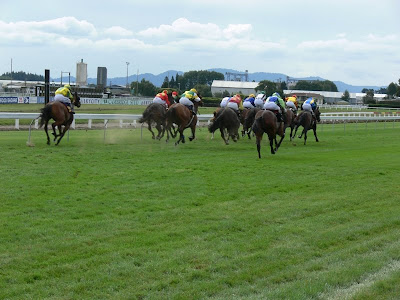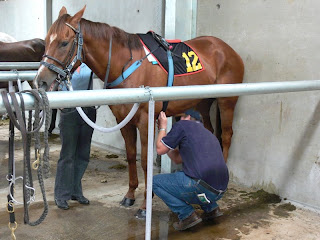Welfare concerns over horse sports
By Dr Clive Dalton
RACING
History
The horse is a ‘panic species’ and escapes its predators by running away, so the faster a horse can run, the greater its chances of survival. Man soon realised the vale of this trait for in war and then for leisure. Clearly, the person with the fastest horse would soon gain elevated status in human society, and very soon after this you could see the emergence of betting.
So horses have been bred for generations to race in various forms for human entertainment, the main one being flat racing by ‘thoroughbreds’ and trotting and pacing in ‘harness racing’ where the driver is carried in a sulky pulled behind the horse. Racing horses over jumps is simply a modification of flat racing.
The Domestic Contract
When considering the points below, remember to consider ‘The Domestic Contract’ which is about man and the animal coming to a compromise or ‘Win-Win’ situation. Remember that man has to do the negotiation fairly for both parties as the horse cannot. Consider the main forms of racing below.
Flat, jumps and harness racing
From man’s viewpoint
- Horses have been bred for racing so suffer little stress when pushed hard by rider or driver.
- The training of these horses provides more conditioning, which again ensures minimal stress when performing, especially at their peak speed at the end of races.
- Many trainers, drivers and jockeys state that horses actually enjoy racing, and this can be seen in the way they get excited immediately before starting an event.
- The whipping of horses in the final stages of a race is minimal, and causes little pain or distress to the horse over a very short time interval.
- Whipping in moderation is acceptable and is needed to help the horse ‘concentrate on its work’.
- The massive racing industry employs many people and in New Zealand and money from betting also goes into the general community.
- The industry also contributes to national wealth through the export of horses.
From the horse’s viewpoint
If it had a choice, what would it do?
- If horses, even those bred for racing were given a choice, they would not want to race, which is equivalent to having a session of ‘panic stress’.
- The hide of the horse is a very sensitive organ, as it can feel and flick off a fly from a specific area. So whipping is something the horse must view as a stressor.
- To inflict such distress on an animal for human entertainment is not acceptable in this modern age.
- It is humans who have decided how much whipping is acceptable, and the horse has never been tested for reaction.
- Limiting jockeys in flat racing to six successive cuts with the whip, then six whip-less strides before another six whippings before it is deemed to be ‘unfair’ is an outrageous rule made by man ignoring the desires of the horse.
- Research to check the physiological response of horses to whipping should have been done before rules were made. Remember that the Animal Welfare Act prides itself on the fact that recommendations should be based on good science.
- Whipping causes distress and pain to a horse and goes against all the principles in the current law.
Some other points
 Horses getting the legal six whips, then after six strides, getting another
Horses getting the legal six whips, then after six strides, getting anothersix whips - for whose benefit?
- To protect the horse, the MAF Code of Welfare on Horses No 7 (1993) states that ‘except during races under the control of the New Zealand Racing Conference or New Zealand Harness Racing Conference, no person may inflict upon a horse more than three consecutive strokes with a whip, and ‘No person may strike any horse around the head or genitals with a whip or other object’.
- The argument is confused under the definition of ‘cruelty’ which the law does not allow under any circumstance. Whipping of racehorses by the industry has clearly been deemed by humans not to be cruel if it is limited to six consecutive strokes at a time.
- It would be interesting to know how six was decided and why six strides before another six lashes. Was this based on reliable research of some human ‘feeling? Did anyone volunteer to be whipped to try to get an idea of what the horse was feeling?
- New Zealand Thoroughbred Racing changed the rules from August 1 2009 to ban the old style whip and make the use of the 'padded whip' mandatory. This follows extensive trials in UK, Ireland, India and Australia which showed that the padded whip makes more noise and causes less stress to the horse. Jockeys in these countries and New Zealand argue that a whip is needed to steer the horse and not inflict pain.
Old whip (top) and padded whip (bottom)
- The MAF Horse Code has a lot of comment on ‘discipline and restraint methods’ where as most people know, the whip is a recognised tool of trade. But the Code is very clear that ‘training methods which involve cruelly ill-treating horses is unacceptable’.
- There is such a surplus of race horses that don’t make the big time, and not enough people who are willing to take them, that they form a major part of the pet food industry. At least this industry is tightly controlled so they do have a humane death. Thoroughbreds especially, are not suitable for family horses.
- Some countries are considering a ban on whipping horses in races, and it would be a great opportunity for New Zealand to lead the way.
- Steeplechase racing over jumps has the added issue of making horses jump fences risking injury, on top of being whipped in the last stages of a race when they are exhausted.
- ‘Eventing’ has gained a bad press when at the highest level of the sport, (e.g. Olympics and Badmington), horses have been injured on the cross-country course and have to be put down. The human making courses wanted to make it more challenging (harder) for the horse, in theory to sort out the very best horse and for crowd entertainment, and the welfare of the horse was compromised.
- The public outcry has done some good, in that designers of courses have had to give human and animal safety a much greater priority.
RODEOS
America is the home of the Rodeo, and they are legal in New Zealand, but many countries in the world have banned them. Here’s a summary of the main points from each side for you to test the ‘Domestic Contract’ idea.
Man’s viewpoint
(My interpretation of points put forward by the NZ Rodeo Cowboys’ Association)
- The ‘sport’ is tightly controlled by the Association.
- It is also controlled under the Animal Welfare Act 1999 by the MAF Rodeos Code of Welfare 2003, No 2. Here a veterinarian must be in attendance at al times at any event to ensure animal welfare.
- Rodeos are part of New Zealand culture and history so are a legitimate sport.
- Horses kept for rodeo work are well fed and looked after at all times. It’s in the interests of the owner of these horses to keep them fit for their performances.
- A horse only has to buck for a very short time, so any stress caused is very short.
From the horse’s viewpoint
- Rodeos never were part of Kiwi culture or history where horses needed to be broken in by letting them buck to submission. It can never be claimed to be a legitimate sport.
- Bucking by a horse is its way to dislodge a predator, so when it does this, it is in panic mode and highly distressed.
- Rodeo horses may be well looked after most of their lives, but the cruelty they are subjected to cannot be justified under the ‘Five Freedoms’ which underpins the Animal Welfare Act.
- The horse has no choice as to whether it would prefer to be ridden by a predator.
Some other points
- The practice of rodeos is not based on scientific research on the welfare of the horse, which again is the basis of the Act.
- As a country exporting animal products, allowing the sport of rodeos does not create a good image when we try to tell customers that New Zealand is ‘clean, green and humane’.
- The Code says that ‘The judges and the animal welfare officer should be empowered to disqualify any official or contestant who compromises the welfare of an animal’.
- So when does the riding of a horse and spurring it to ensure it keeps bucking (which is scored for points) NOT compromise the welfare of the animal?






No comments:
Post a Comment